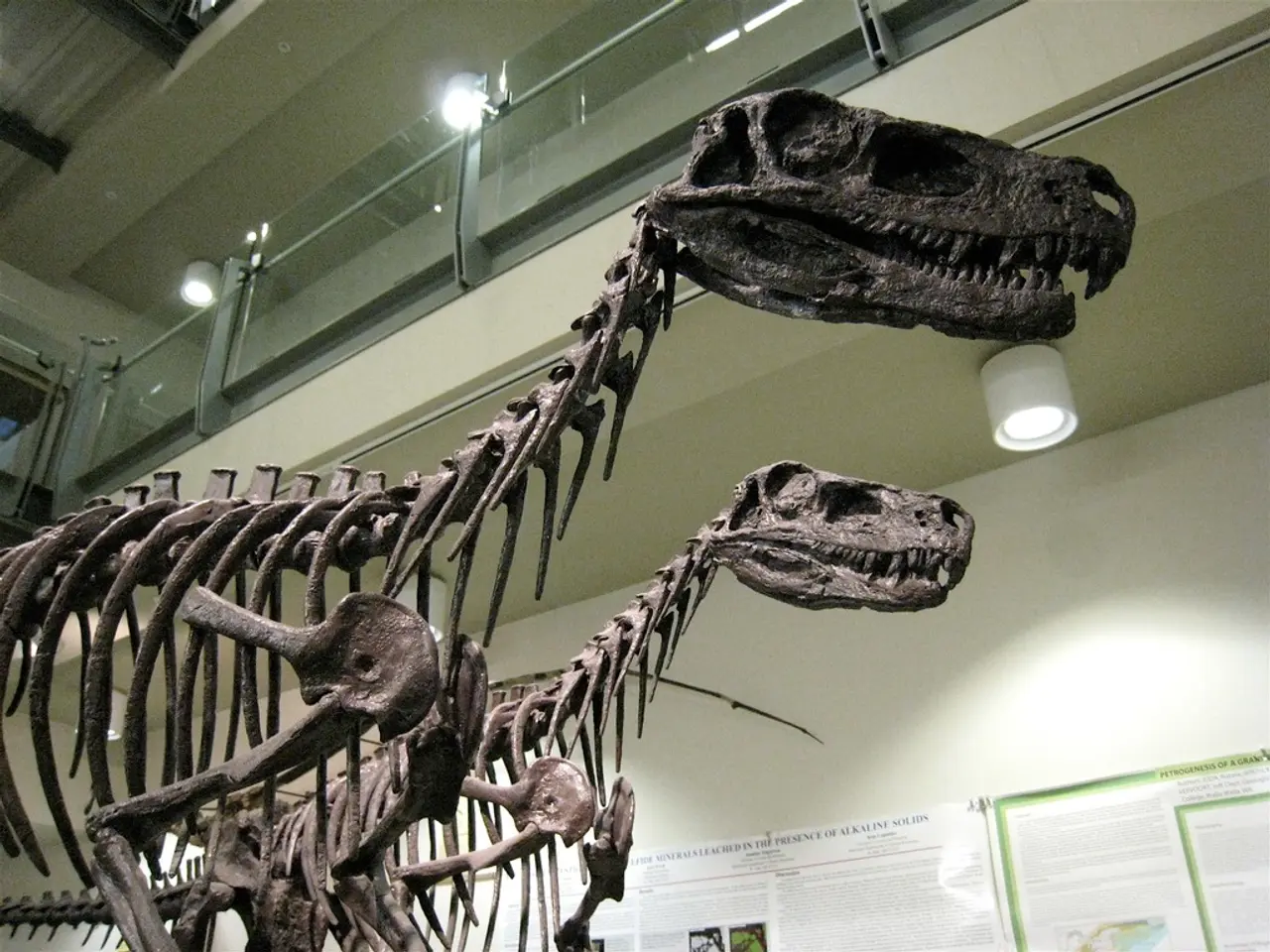Study reveals feeding methods of T. rex and other dinosaurs, as analyzed through biomechanics
In a groundbreaking study led by vertebrate paleontologist Andre Rowe of the University of Bristol, the feeding biomechanics of 17 species of meat-eating dinosaurs have been explored, providing insights into the diverse predatory strategies that thrived during the age of dinosaurs.
Among the dinosaurs under investigation, three giants - Tyrannosaurus rex, Giganotosaurus, and Spinosaurus - stood out due to their significant variations in feeding strategies.
Tyrannosaurus rex, renowned for its fearsome size and powerful build, boasted a shorter and thicker skull designed for delivering quick, strong, bone-crushing bites. This powerful bite force, similar to that of crocodiles, was optimized for strength, allowing it to break bones and access marrow. This strategy proved effective in highly competitive Late Cretaceous environments, involving directly crushing prey [2][3][5].
In contrast, Giganotosaurus, which predated Tyrannosaurus by roughly 30 million years, had an elongated skull with thin, serrated blade-like teeth, specialized for slicing and tearing large chunks of flesh rather than crushing bone. Its bite was relatively lighter in force and more adapted for slashing, akin to a combination of great white shark and Komodo dragon tooth function [1][4][5].
Spinosaurus, another prehistoric predator, had a distinct adaptation as a semi-aquatic predator, with jaws and teeth like a crocodile. However, its feeding strategy focused on catching large fish rather than large land prey. Its bite strength was weaker than Tyrannosaurus, and its skull was specialized for seizing slippery aquatic prey [1][4].
The study revealed that although these large theropods shared a big size and carnivorous diets, their skull structures and feeding biomechanics developed along different evolutionary paths. T. rex favoured brute force crushing, Giganotosaurus and other allosaurs employed slicing and ripping, and Spinosaurus specialized in aquatic prey capture. These findings illustrate a diversity of effective predatory strategies rather than a single optimal design among giant meat-eating dinosaurs [3][5].
The researchers estimated muscle forces using digital muscle reconstructions based on living relatives of dinosaurs (birds and crocodiles). The study used 3D models of the skulls of the 17 species and a method for simulating how structures respond to physical stress.
The study found that not all theropods evolved to have a high bite force; there was a spectrum of ecological adaptations among the species. Early theropods examined in the study, such as Herrerasaurus and Dilophosaurus, exhibited much lower stress resistance than their later counterparts. They were not well adapted to high bite forces.
Interestingly, the study found that other dinosaur predators evolved successful approaches to bringing down prey without matching the T. rex bite force. For instance, Giganotosaurus relied more on slashing and ripping flesh, while Spinosaurus had a long, narrow snout, which suggests a diet focused on fishing, but it also ate other animals.
The largest known Tyrannosaurus specimen is named Sue, located at the Field Museum in Chicago, at 40-1/2 feet (12.3 meters) long. Tyrannosaurus, along with Daspletosaurus and Albertosaurus, had the highest skull strength and bite mechanics among the studied species, appearing late in the Cretaceous Period.
The evolutionary flexibility among theropods likely helped them dominate ecosystems for a long time, as they developed a variety of effective predatory strategies to suit their environments and prey. This comprehensive analysis of the skull design and bite force of various species offers valuable insights into the adaptability and diversity of dinosaurs, enriching our understanding of these fascinating creatures.
- Despite sharing a carnivorous diet with Tyrannosaurus rex, the feeding strategy of Spinosaurus differed, as it specialized in capturing large fish, employing a crocodile-like bite and having a skull adapted for seizing slippery aquatic prey.
- In the study, it was found that not all theropods evolved to have a high bite force; instead, there was a spectrum of ecological adaptations among the species, with Giganotosaurus, for example, relying more on slashing and ripping flesh, rather than matching the T. rex bite force.




